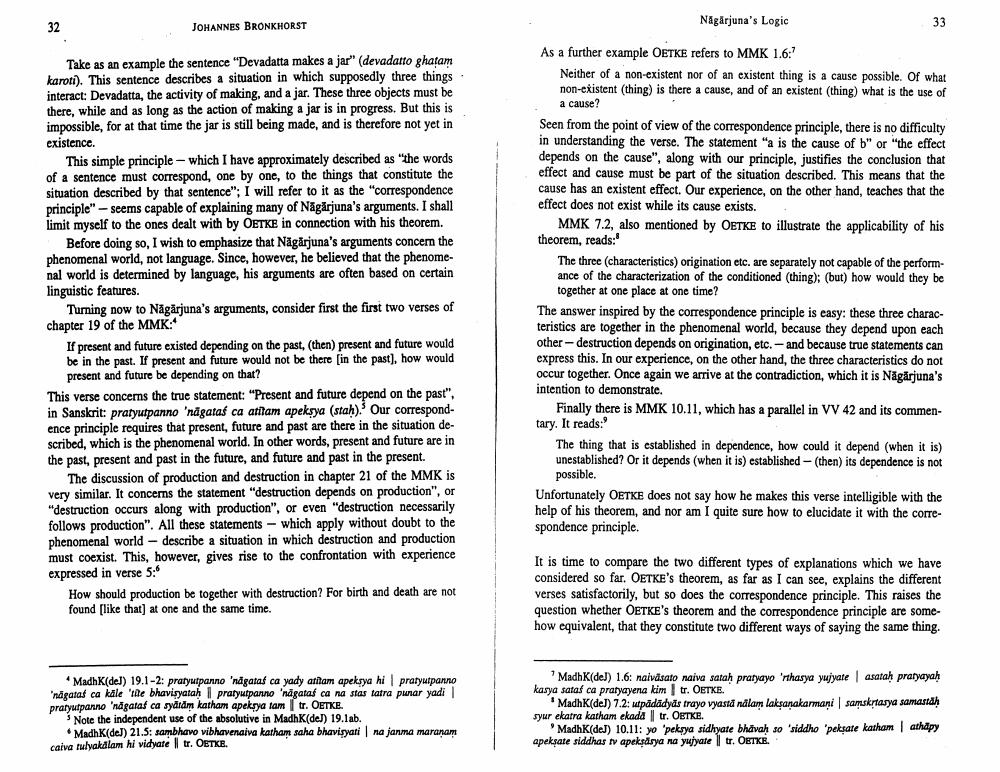Book Title: Nagarjuna Logic Author(s): Johannes Bronkhorst Publisher: Johannes Bronkhorst View full book textPage 3
________________ Nagarjuna's Logic JOHANNES BRONKHORST Take as an example the sentence "Devadatta makes a jar" (devadatto ghatam karoti). This sentence describes a situation in which supposedly three things interact: Devadatta, the activity of making, and a jar. These three objects must be there, while and as long as the action of making a jar is in progress. But this is impossible, for at that time the jar is still being made, and is therefore not yet in existence. This simple principle - which I have approximately described as "the words of a sentence must correspond, one by one, to the things that constitute the situation described by that sentence": I will refer to it as the "correspondence principle" - seems capable of explaining many of Nagarjuna's arguments. I shall limit myself to the ones dealt with by OETKE in connection with his theorem. Before doing so, I wish to emphasize that Nagarjuna's arguments concern the phenomenal world, not language. Since, however, he believed that the phenomenal world is determined by language, his arguments are often based on certain linguistic features. Turning now to Nāgārjuna's arguments, consider first the first two verses of chapter 19 of the MMK: If present and future existed depending on the past, (then) present and future would be in the past. If present and future would not be there in the past), how would present and future be depending on that? This verse concerns the true statement: “Present and future depend on the past". in Sanskrit: pratyutpanno 'nāgataś ca atitam apeksya (stah). Our correspondence principle requires that present, future and past are there in the situation described, which is the phenomenal world. In other words, present and future are in the past, present and past in the future, and future and past in the present. The discussion of production and destruction in chapter 21 of the MMK is very similar. It concerns the statement "destruction depends on production", or "destruction occurs along with production", or even "destruction necessarily follows production". All these statements - which apply without doubt to the phenomenal world - describe a situation in which destruction and production must coexist. This, however, gives rise to the confrontation with experience expressed in verse 5: How should production be together with destruction? For birth and death are not found (like that) at one and the same time. As a further example OETKE refers to MMK 1.6:? Neither of a non-existent nor of an existent thing is a cause possible. Of what non-existent (thing) is there a cause, and of an existent (thing) what is the use of a cause? Seen from the point of view of the correspondence principle, there is no difficulty in understanding the verse. The statement "a is the cause of b" or "the effect depends on the cause", along with our principle, justifies the conclusion that effect and cause must be part of the situation described. This means that the cause has an existent effect. Our experience, on the other hand, teaches that the effect does not exist while its cause exists. MMK 7.2, also mentioned by OETKE to illustrate the applicability of his theorem, reads: The three (characteristics) origination etc. are separately not capable of the performance of the characterization of the conditioned (thing): (but) how would they be together at one place at one time? The answer inspired by the correspondence principle is easy: these three characteristics are together in the phenomenal world, because they depend upon each other - destruction depends on origination, etc. - and because true statements can express this. In our experience, on the other hand, the three characteristics do not occur together. Once again we arrive at the contradiction, which it is Nägarjuna's intention to demonstrate. Finally there is MMK 10.11, which has a parallel in VV 42 and its commentary. It reads: The thing that is established in dependence, how could it depend (when it is) unestablished? Or it depends (when it is established -(then) its dependence is not possible. Unfortunately OETKE does not say how he makes this verse intelligible with the help of his theorem, and nor am I quite sure how to elucidate it with the correspondence principle. It is time to compare the two different types of explanations which we have considered so far. OETKE's theorem, as far as I can see, explains the different verses satisfactorily, but so does the correspondence principle. This raises the question whether OETKE's theorem and the correspondence principle are somehow equivalent, that they constitute two different ways of saying the same thing. MadhK(de]) 19.1-2: pratyulpanno 'nāgataś ca yady atitam apeksya hi pratyutpanno indgatas ca kale 'rate bhavisyatah pratyutpanno 'nagatas ca na stas tatra punar yadi pratyulpanno 'nagata ca sydtdm katham apeksya tamtr. OETKE. Note the independent use of the absolutive in MadhK(del) 19.1ab. • MadhK(de) 21.5: sambhavo vibhavenaiva katham saha bhavisyati na janma maranam caiva rulyakalam hi vidyate | tr. OETKE. MadhK(de)) 1.6: naivdsato naiva satah pratyayo 'thasya yujyate asatah pratyayah kasya satasca pratyayena kimtr. OETKE. MadhKdeJ) 7.2: utpādādyās frayo vyasta nálam laksanakarmani samskrtasya samasta syur ekatra katham ekada tr. OETKE. MadhK(deJ) 10.11: yo 'peksya sidhyate bhāvah so 'siddho 'peksate katham athapy apeksate siddhas tv apeksärya na yujyate tr. OETKE.Page Navigation
1 2 3 4 5
